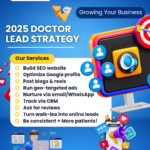- November 30, 2025
- by
- Uncategorized
- 0 Comments
Inbound vs. Outbound Marketing: Which Strategy Delivers Better Results?
In the fast-evolving world of marketing, one burning question continues to spark debate among business owners and marketers alike:
“Inbound vs. Outbound — which one drives better results?”
Both strategies aim to grow your brand and drive sales, but the path they take is completely different. Choosing the right one can be the difference between a marketing win and wasted budget.
Let’s dive into the pros, cons, and best uses of each, and help you figure out when it’s time to bring in the pros (a.k.a. hire an agency 😉).
🔍 What is Inbound Marketing?
Inbound marketing is all about attracting your ideal customers organically. Instead of pushing your message out, you create valuable content that pulls people in.
Common Inbound Tactics:
- ✅ Blogging
- ✅ SEO (Search Engine Optimization)
- ✅ Email nurturing
- ✅ Social media content
- ✅ Webinars, eBooks, & guides
🚀 Pros:
- Builds long-term trust 🛠️
- Lower cost over time 💰
- Attracts higher-quality leads 🧲
🐌 Cons:
- Takes time to see results 🕒
- Requires consistent content creation ✍️
- Needs strong SEO knowledge 🔍
Best for: Businesses playing the long game, content-driven brands, B2B companies, and startups looking to build brand awareness.
📢 What is Outbound Marketing?
Outbound marketing pushes your message out to a broad audience, often interrupting their day in hopes of grabbing their attention.
Common Outbound Tactics:
- 📺 TV, radio, and print ads
- 📩 Cold emails & cold calls
- 📦 Direct mail
- 📈 PPC ads (Google, Facebook, etc.)
- 🧊 Display ads & sponsorships
🚀 Pros:
- Fast results & visibility ⚡
- Great for launching new products 🧨
- Scales reach quickly 🌍
🐌 Cons:
- Higher upfront costs 💸
- Interruptive = less trusted 😕
- Less targeted, lower engagement 📉
Best for: Product launches, limited-time offers, B2C companies, and brands with larger budgets aiming for rapid growth.
⚔️ Inbound vs. Outbound: Which One Wins?
The truth is… there’s no one-size-fits-all answer.
Here’s a quick head-to-head comparison to help you decide 👇
| Feature | Inbound 🧲 | Outbound 📣 |
|---|---|---|
| Audience | Attracted organically | Reached proactively |
| Cost Over Time | Lower | Higher |
| Speed of Results | Slow & steady 🐢 | Fast & aggressive 🚀 |
| Trust & Credibility | High | Often low |
| Lead Quality | Warm/hot leads 🔥 | Cold leads 🧊 |
| Measurement & ROI | Easier to track | More difficult |
➡️ Use inbound when you’re focused on building brand loyalty, educating your market, or working with a smaller budget over the long term.
➡️ Use outbound when you need fast traction, have a specific campaign, or want instant visibility.
🧠 A Smart Strategy: Combine Both!
Most successful businesses don’t choose one or the other — they blend both.
- Use outbound to generate fast traffic and awareness.
- Use inbound to nurture and convert that traffic into loyal customers.
💡 Example: Run Google Ads (outbound) to drive people to a high-value blog or eBook (inbound). Then follow up with email nurturing.
🧑💼 When Should You Hire a Marketing Agency?
Still unsure which path is right for you? Here are 5 signs it’s time to bring in the experts:
- 🕰️ You don’t have time to create consistent content
- 📉 Your current marketing isn’t delivering results
- 🤔 You’re unclear which channels or strategies work best
- 🚀 You’re scaling fast and need strategic support
- 📊 You want better analytics, tracking, and ROI
An experienced agency can audit your current efforts, design a custom strategy (inbound, outbound, or hybrid), and execute it with precision — saving you time, stress, and budget in the long run.
🎯 Final Thoughts: The Best Strategy is the One That Works for YOU
Whether you choose inbound, outbound, or a hybrid approach, your decision should be based on:
- Your business goals 🎯
- Your budget 💰
- Your timeline ⏳
- Your internal resources 👥
Inbound takes patience. Outbound takes budget.
Together? They’re unstoppable. 💥





